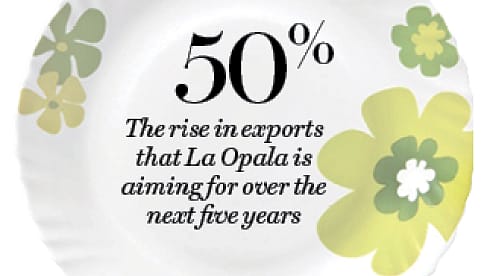La Opala: Plate Tectonics
ADVERTISEMENT

There’s a revolution brewing in Indian kitchens. First came custom-designed kitchens. Now, the demand is for fancy cutlery and crockery—as seen on TV. “Disposable income, cookery shows, and exposure through travel have changed consumption patterns,” says Ankur Bisen, senior vice president, retail and consumer products, at consultancy firm Technopak. Customers are demanding new shapes and designs, microwaveable crockery, inexpensive gift options that look rich, and much more. International players such as Corelle, Luminarc, Bormioli Rocco, and RAK, offer imported plates and bowls to Indian customers, but the cost is often prohibitive.
Enter Kolkata-based La Opala, which prices its products a good 30% to 80% lower. The imposition of anti-dumping duties on opal glassware imports from China and the U.A.E. has also worked in its favour. Demand has been so great that La Opala’s factories, in Bihar and Uttarakhand, are running almost at full capacity. The company is in the process of doubling capacity (from 8,000 tonnes per annum to 16,000 tpa) at the Uttarakhand unit at a cost of Rs 50 crore.
Clearly, the market has been handed to La Opala on a plate. Its stock has delivered total returns of 162% since March 2014. And last year, private equity firm WestBridge Capital picked up a 4.5% stake for Rs 55.3 crore through a preferential allotment.
La Opala’s net revenue grew 24% year on year to Rs 121 crore in the second and third quarter of FY15 combined. “I expect a 20% to 25% increase in La Opala’s revenue and 30% to 35% increase in bottom line in the coming years,” says Jignesh Kamani, research analyst at broking firm Nirmal Bang.
December 2025
The annual Fortune 500 India list, the definitive compendium of corporate performance, is out. This year, the cumulative revenue of the Fortune 500 India companies has breached $2 trillion for the first time. Plus, find out which are the Best B-schools in India.
Last year, La Opala created two price points— Rs 650 for a six-piece dinner set for two-member families, and Rs 999 for a 10-piece set for four-member families. It also introduced gift sets of bowls priced between Rs 250 and Rs 350. The increase in demand has pushed the company to spend up to 20% of its revenue on brand building, compared to 8% till 2012.
Last September, the management of La Opala decided to implement a stock split, dividing each share with a face value of Rs 10 into five of Rs 2. Before the split, La Opala traded at around Rs 1,600; after, it was in the range of Rs 320 to Rs 325. Till FY14, around 18% of La Opala’s Ebitda came from exports, mainly to West Asia, Latin America, and Africa. It is aiming at exports worth Rs 100 crore over the next five years, a growth of 50%.
The La Opala stock was trading at Rs 382 (as of March 13) and Kamani’s target price is Rs 433. He expects that the company’s strategy of launching products at low price points will help it increase its market share.
